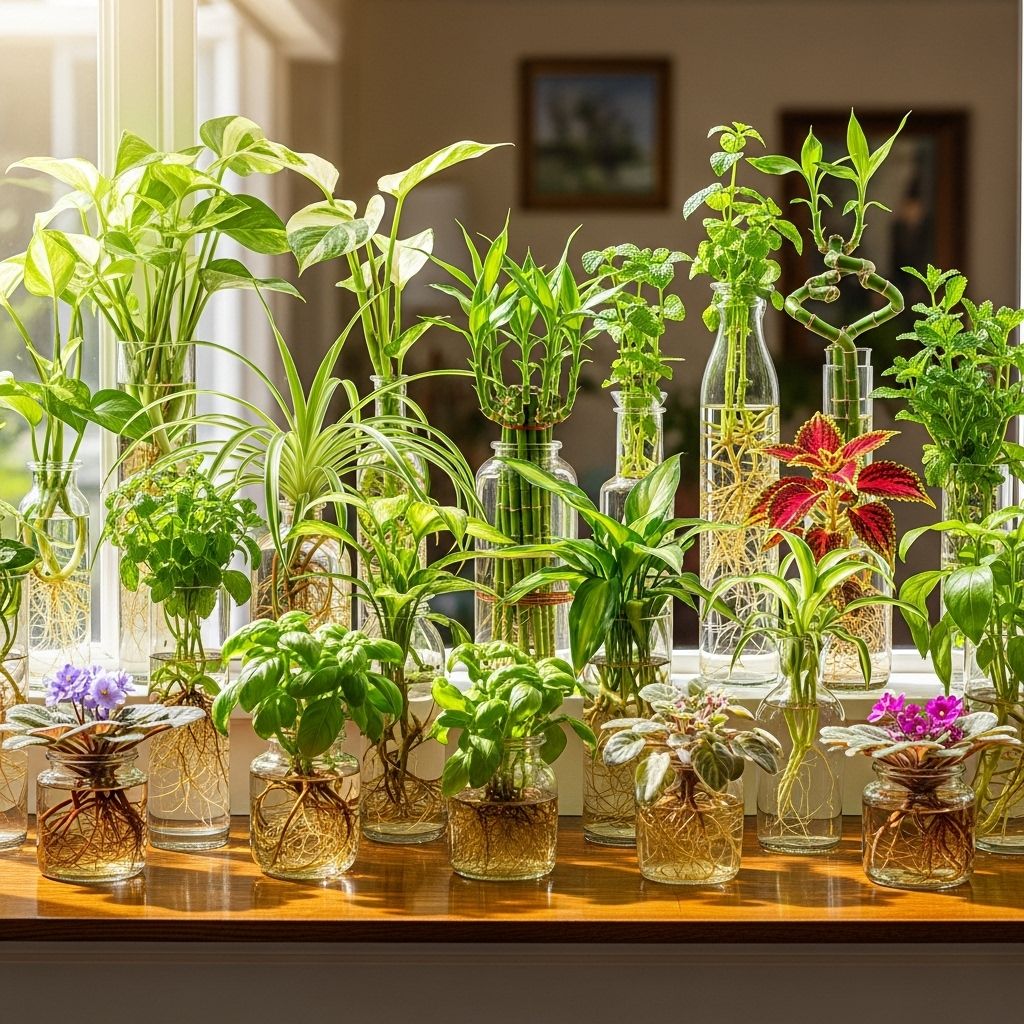42 Fascinating Plants You Can Grow Easily In Water Indoors
Show off elegant root displays with minimal upkeep in clear jars and vases.

Image: HearthJunction Design Team
Introduction to Growing Plants in Water Indoors
Many gardening enthusiasts are embracing the clean, low-maintenance method of growing plants in water instead of soil. Not only does this method eliminate soil mess, but it also allows indoor gardeners to display striking plant arrangements in glass jars or vases. With the right choice of species and a few basic steps, you can maintain lush, healthy plants indefinitely in water—making it perfect for busy plant lovers or those with limited space.
Benefits of Growing Plants in Water
- Mess-free: No spilled soil or repotting hassles.
- Fewer pests: Reduces risk of soil-borne insects and diseases.
- Decorative displays: Transparent glass showcases roots and stems as living art.
- Easy watering: No guesses about soil dryness or overwatering.
- Space-saving: Fits on small surfaces, making it ideal for apartments and offices.
- Educational: Great for watching root development and teaching kids about plants.
Key Considerations for Water-Based Growing
Certain plants are better suited to this lifestyle. Here’s what to keep in mind:
- Choose resilient species: Not all plants adapt well to hydro water growth. Opt for tough houseplants and fast-rooting herbs.
- Light preferences: Place vases in bright, indirect sunlight unless otherwise noted for the species.
- Clean water: Use filtered, distilled, or tap water (if not highly chlorinated). Change water regularly to prevent cloudiness or rot.
- Nutrient boost: Add diluted liquid fertilizer once a month for long-term growth, as water lacks soil nutrients.
- Prepping cuttings: Remove lower leaves to prevent rot and use clean, sharp scissors or pruners.
How to Start: Growing Plants in Water Step by Step
- Choose Your Container: Glass jars, vases, or repurposed bottles are ideal. Clear containers let you watch root growth.
- Prepare Cuttings: Cut a healthy stem below a node (the bump where leaves join the stem). Remove leaves that would sit below the water line.
- Add Water: Fill container with room temperature filtered or tap water. Avoid putting leaves underwater.
- Place Carefully: Keep out of direct sun, but in a spot with plenty of indirect light for most species.
- Monitor Growth: Replace water every 1–2 weeks, rinse the container, and trim roots if needed.
- Fertilize Lightly: Every 3–4 weeks, add diluted liquid fertilizer formulated for houseplants if you plan to keep the plant in water long term.
42 Best Plants That Grow in Water Indoors
The following plants can all grow in water either indefinitely or for extended periods. Each offers unique foliage, fragrance, or flowers—without the hassle of soil!
- Pothos (Epipremnum aureum): Famous for easy rooting and trailing vines.
- Philodendron: Heartleaf and similar varieties thrive in water jars.
- Peace Lily (Spathiphyllum): Grows well; just ensure roots are always submerged.
- Spider Plant (Chlorophytum comosum): Root “pups” or offshoots in water.
- Lucky Bamboo (Dracaena sanderiana): Often seen in water vases; not a true bamboo, but very tolerant.
- Chinese Evergreen (Aglaonema): Colorful, patterned leaves and low care needs.
- Monstera deliciosa: Iconic split leaves; stem cuttings root easily.
- Dieffenbachia (Dumb Cane): Root stem cuttings away from pets and children.
- English Ivy (Hedera helix): Easily propagated from cuttings in water.
- Tradescantia (Wandering Dude): Fast-growing and colorful for sprucing up any vase.
- Syngonium (Arrowhead Vine): Arrow-shaped foliage develops roots quickly.
- Coleus: Vibrant leaves make stunning water-grown accents.
- Peppermint, Spearmint & Other Mints: Fresh flavor and aromatic leaves for teas or garnish.
- Basil: A kitchen favorite; enjoys sunny windowsills and frequent water changes.
- Rosemary: Woody cuttings take a bit longer, but will root with patience.
- Oregano: Soft stems root reliably in water containers.
- Thyme: Delicate sprigs do well in bright, filtered light.
- Parsley: Enjoys plenty of indirect sunlight for bushy growth.
- Sage: Woody stems require patience and consistent water changes.
- Lavender: For fragrant roots and water-grown bouquets.
- Green Onion (Scallion): Place roots in water and harvest greens perpetually.
- Garlic: Put a clove in a shallow dish; watch green shoots emerge.
- Celery: Grow new stalks from the base of old store-bought celery.
- Sweet Potato Vine: Decorative vines grow from a suspended tuber laid partly in water.
- Lettuce: Leafy ends sprout new growth with direct light.
- Chives: Snip leaves continually as they regrow in water.
- Pineapple Top: Place in water—roots will form and you’ll grow long spiky leaves.
- Begonia: Both wax and rex types root easily from stem cuttings.
- Rex Begonia: Spectacular foliage in a water jar centerpiece.
- Rubber Plant (Ficus elastica): Slow rooting but long-lived; change water as you wait.
- Fiddle Leaf Fig (Ficus lyrata): Young stems root in water before or instead of soil transfer.
- Jade Plant (Crassula ovata): Try snippets of this popular succulent for water propagation.
- Hoya: “Wax plant” stems thrive in liquid culture for months.
- Arrowhead Plant: Broad, arrow-shaped leaves root quickly in vases.
- Aluminum Plant (Pilea cadierei): Unusual silver-spotted foliage for a unique window feature.
- Polka Dot Plant (Hypoestes phyllostachya): Pink-dotted leaves charm in a glass jar.
- Fittonia (Nerve Plant): Small, veined leaves for terrarium-like water gardens.
- ZZ Plant (Zamioculcas zamiifolia): Can root from cuttings, especially in bright, indirect light.
- Asparagus Fern: Soft fronds root at the base of stem cuttings in water.
- African Violet: Choose a leaf cutting and watch new plants form at the base.
- Caladium: Colorful foliage forms roots when hydrated in water.
- Paperwhite Narcissus: Watch bulbs bloom in shallow water over stones for indoor winter cheer.
- Hyacinth: Fragrant bulbs are often grown in water-filled bulb glasses.
- Amaryllis: Dramatic holiday blooms in water with a support base.
Special Highlight: Herbs and Kitchen Crops in Water
Herbs like mint, basil, oregano, rosemary, and sage are not only simple to grow in water, they’ll also provide you with constant fresh garnish for cooking. Edible household plants such as celery, lettuce, and scallions can regenerate from leftover kitchen scraps—simply place the root ends in a shallow dish of water and let nature take its course. Regular harvesting keeps them growing and prevents legginess.
Common Problems and How to Avoid Them
- Cloudy or smelly water: Rinse the jar and change water often. Remove any decaying organic matter promptly.
- Algal growth: If algae form, move jars to a location with less direct light or use opaque containers.
- Root rot: Only submerge stems, not leaves. Discard any slimy or brown roots.
- Slow or no root development: Try a different cutting and use fresh water with more indirect light.
- Leggy or pale growth: Plants may need more light or an occasional weak fertilizer feed.
Hydroponics vs. Simple Water Growing
| Simple Water Growing | Hydroponics |
|---|---|
| Only uses plain water or lightly fertilized water | Uses nutrient-rich water solutions specifically balanced for plant growth |
| Great for cuttings and low-maintenance houseplants | Suitable for vegetables, fruits, and larger-scale food production |
| No pumps or special equipment required | Often uses pumps, lights, timers, and pH testing |
| Decorative focus | Productivity and efficiency focus |
Maintenance Tips for Healthy Water-Grown Plants
- Refresh water weekly or as soon as it turns cloudy.
- Rinse roots gently during each water change to prevent dirt and decay buildup.
- For foliage plants, trim stems and roots regularly to encourage bushy growth.
- Add a diluted liquid fertilizer monthly; look for one designed for hydroponics or houseplants.
- Use room-temperature water, and avoid water that’s been treated with chlorine or softeners.
- Check for pests such as fungus gnats, especially if organic debris is present.
Frequently Asked Questions (FAQs)
Q: Can I grow any plant in water forever?
A: No, not all plants tolerate long-term water culture. Some, like cacti and most succulents, require soil for healthy growth, while many leafy houseplants and herbs adapt well. Test with cuttings, and stick with species known to succeed, as listed above.
Q: How often should I change the water?
A: Ideally, change the water weekly or when it becomes cloudy or develops an odor. Fresh water prevents bacteria and promotes healthy roots.
Q: Do I need to add fertilizer for plants to thrive in water?
A: Yes, if you plan to keep plants in water long-term, add a few drops of liquid fertilizer every 3–4 weeks. Without soil nutrients, plants will eventually decline without supplementation.
Q: Is tap water safe for plants grown in water?
A: Most city tap water is fine, but let it sit out overnight to allow chlorine to dissipate, or use filtered water for sensitive species. Avoid softened water, which contains salts that can harm plant roots.
Q: Can I grow flowering plants in water?
A: Yes, many bulbs (like paperwhite narcissus, hyacinth, and amaryllis) and some tropical plants will flower when grown in water. Regular fertilizer and strong light boost bloom performance.
Q: What are the signs a plant is struggling in water?
A: Yellowing leaves, slimy or brown roots, and foul-smelling water are common signs of trouble. Promptly rinse the plant, trim away affected roots, and replace with clean water.
Conclusion
Growing plants in water is an easy, flexible, and visually stunning way to build your indoor garden. Whether your style is glass jars of herbs in the kitchen or lush foliage in your living space, the right plant species will reward you with effortless care and year-round beauty. Start with water-loving favorites like pothos, mint, and lucky bamboo, then experiment and curate your own thriving, soil-free plant paradise.
References
Read full bio of Shinta












